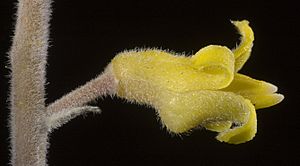Persoonia saccata facts for kids
Quick facts for kids Persoonia saccata |
|
|---|---|
 |
|
| Scientific classification | |
| Genus: |
Persoonia
|
| Species: |
saccata
|
| Synonyms | |
|
Linkia saccata (R.Br.) Kuntze |
|
Persoonia saccata, often called snottygobble or cadgeegurrup (an Indigenous name), is a special plant from the Proteaceae family. It grows only in the south-west part of Western Australia. This plant is usually a tall shrub with long, thin leaves. It has groups of up to fifty or more bright yellow flowers that look a bit irregular and are hairy on the outside. You'll often find it growing in woodlands where trees like jarrah (Eucalyptus marginata), marri (Corymbia calophylla), or large Banksia species are common.
Contents
What Does Persoonia saccata Look Like?
Persoonia saccata is usually a shrub that stands upright, but sometimes it spreads out. It can grow from about 0.2 m (0.7 ft) to 1.5 m (5 ft) tall. It has many main stems and a large underground lignotuber, which is like a woody lump that helps it survive.
Leaves and Stems
The bark on the main stem is mostly smooth and grey. Its leaves are arranged one after another along the stem. They are long and thin, like a line, measuring about 50 mm (2 in) to 170 mm (7 in) long and only about 1 mm (0.04 in) wide. The edges of the leaves are rolled under. When the leaves are young, they are soft and flexible, and they have tiny hairs. Both sides of the leaves are the same color, and you usually can't see the veins.
Flowers and Fruit
The flowers grow in groups of ten to fifty or more. These groups appear at the ends of branches or where leaves join the stem. Each flower sits on a hairy stalk called a pedicel, which is about 3.5 mm (0.1 in) to 12 mm (0.5 in) long. The whole group of flowers has a longer stalk, from 20 mm (0.8 in) to 250 mm (10 in) long.
The flowers are bright yellow and have four parts called tepals, which are like petals. These tepals are 9 mm (0.4 in) to 14 mm (0.6 in) long and are hairy on the outside. They are joined at the bottom, but their tips curl back. The lowest tepal has a unique sac-like or pouch-like shape, which is where the name saccata comes from.
In the center of the flower, there's a style surrounded by four bright yellow anthers. These anthers have white tips and are different lengths. They are joined to the tepals from top to bottom. Persoonia saccata flowers from July to January. After flowering, it produces smooth, oval-shaped fruits called drupes. Inside each fruit is a nut-like seed, about 8 mm (0.3 in) to 11 mm (0.4 in) long.
Naming the Plant
The scientific name Persoonia saccata was first officially described in 1830 by a botanist named Robert Brown. He published his description in a book called Supplementum primum Prodromi florae Novae Hollandiae.
The second part of the name, saccata, comes from the Latin word sacca, which means "bag". This refers to the unique pouch-like shape of the lowest tepal in the flower.
Where Persoonia saccata Lives
This plant grows in forests or woodlands in Western Australia. It likes areas where jarrah or marri trees are common, and sometimes you can find it near large banksia plants too.
It is found in coastal areas between Lake Pinjar and the Blackwood River. This covers several natural regions in Western Australia, including the Avon Wheatbelt, Esperance Plains, Jarrah Forest, Swan Coastal Plain, and Warren areas.
How Persoonia saccata Grows and Survives
This plant is very good at growing back after a bushfire. It has a special woody underground part called a lignotuber, which helps it survive fires. After a fire, it grows back strongly and produces many flowers the next summer. However, the number of flowers it produces goes down in the years that follow. Eventually, the plant might only grow short shoots and stop producing flowers for a while.
Is Persoonia saccata Endangered?
The Western Australian Government's Department of Parks and Wildlife has classified Persoonia saccata as "not threatened." This means it is not currently at risk of disappearing.

